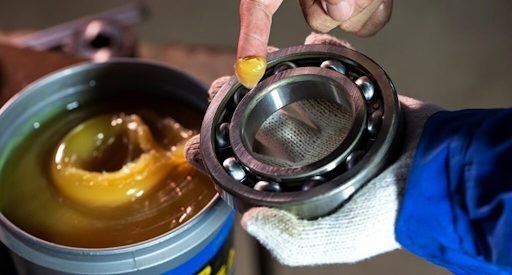To improve the serviceability of machines and equipment lubrication is a must. Lubricants help to reduce friction between the moving parts, prevent wear and improve durability. One of the most common lubricants used is grease.
Grease is a semi-solid lubricant and exhibits properties between the liquid and the solid lubricants. Grease can withstand the movement of small loads and in this case, it acts as a solid lubricant. It exists in the shape imparted to them at room temperature and does not flow. As the load increases the grease gets deformed and starts to flow like a liquid lubricant. When the load is removed it reverses to a solid state.
Due to its properties, grease has an advantage over lubricating oils. One of the main features of grease is that its viscosity varies with the shear rate. As the shear rate increases the viscosity of grease begins to drop. Other features of grease include the ability to hold on to the unsealed lubricating points and work over a wide temperature range and speeds. It has better lubricity, offers a higher corrosion resistance and is economical to use in applications.
Components of grease
In the simplest form grease is made up of a base oil, a thickener and additives. Usually, petroleum oils or synthetic oils are used as a base oil. For thickeners salts with high molecular weight are used like carboxylic acids (soaps) and solid hydrocarbons like silica gel, bentonites, polymers, urea derivatives and more. Various additives and fillers are added to improve the properties of grease.
Base oil
Different types of lubricating oil and liquids are used as a base oil. About 99% of the grease is made from petroleum oil. The nature, boiling range and chemical group of the base oil decide the characteristics of grease. It can affect the serviceability of greases in the temperature range, speed, loads, oxidation, protection and corrosion resistance.
A variety of synthetic oils are used where the petroleum-based greases do not meet the application’s requirements. Synthetic oils used are esters of fatty acids, dibasic acids, polysiloxanes and more. They can function under a broad temperature range, speed ranges, high loads, deep vacuum and corrosive environments.
Thickeners
The main characteristic of grease is determined by the type of thickener used. The three main types of thinners are as follows:
- Polymorphic thickeners interact with the base oil and as the temperature increases the interaction strengthens. For example, soaps. This type of grease is called soap-based grease. Based on the soap cation used they are further subdivided into alkali metal greases like lithium and sodium and alkali earth metal greases like Calcium and Barium. Gasses that use mild soaps are called soap-based greases. Greases that use other soaps are aluminium, lead and more.
- Thickeners that do not show polymorphism but melt at relatively low temperatures and form homogeneous solutions. For example, Solid hydrocarbons. This type of grease is called hydrocarbon grease. Some of the sold hydrocarbons are paraffin, ceresine, petrolatum and more.
- Heat-resistant thickeners that do not dissolve in the base oil and do not undergo any phase change as the temperature rises but interact with the base oil. For example, silica gels, carbon black, pigments and more.
Soaps and solid hydrocarbons are the most popularly used thickeners and account for 99% of the grease produced. Soaps are widely used as they do not interact with the base oil. As the temperature increases they disperse colloidally in base oil.
Additives
The additives or fillers are the third component of grease. Additives are different from fillers as they are soluble in the base oil. Fillers can be considered to be components of thickeners. The additives and fillers are added to improve the properties of greases.
The main additives used are oxidation inhibitors (antioxidants), antiwear, antiseizure, corrosion inhibitors, antifriction, protective, viscous, adhesive and thickening.
When some of the additives are added they may impair the other characteristics. Therefore they should be selected carefully. Most greases use antioxidants as severe operational temperatures can accelerate their oxidation. High-temperature grease should not be produced without antioxidation additives.
Many thickeners significantly improve the antifriction, antiwear, antiseizure and protective properties of the grease. Soaps and polymers improve the lubricity of the base oil and urea derivatives improve the antioxidation and protective properties of grease. Many pigments serve as good antioxidants and antiwear additives.
Fillers are solid additions and do not form a colloidal structure with grease and are added to improve the performance characteristics of grease. They are used to improve lubricity, chemical properties and thermal stability.





